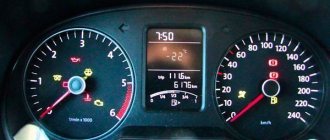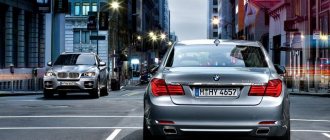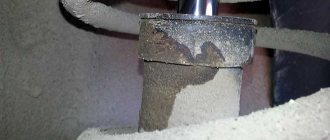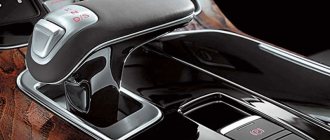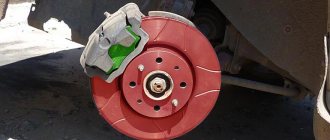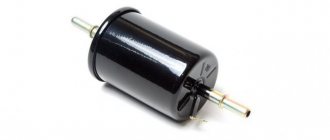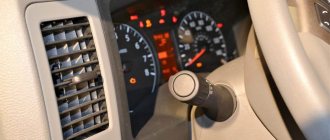Spread out as if in a hammock, or vice versa, bent over, hoping to see the edge of the hood - the driving position, like nothing else, distinguishes a confident driver from a beginner. The professional is also immediately noticeable: the chair is slightly tilted, the arms are bent at the elbows. Incredible but true: both palms rest in the lugs of the steering wheel. Moreover, the master’s legs also stand according to certain rules. Because only in this body position will the driver be able to perform a life-saving maneuver in an emergency situation. More information about how to properly set up the driver's seat is on the pages of the 4R.ru portal.
The importance of driving position
Medical experts believe that the greatest harm to a person comes from a sitting position. But there is no way to drive a car in a standing position, so let’s look at some tips that are aimed at reducing stress, and also so that the driver is prepared for extreme road situations.
Why is so much attention paid to proper driving position?
- Creates proper blood circulation.
- Provides a quick response to extreme road situations.
- The correct driver position allows him to be behind the wheel for a long time without much fatigue.
When an accident occurs, the driver most often succumbs to the influence of his instincts. Before a collision, he spontaneously rests on the steering wheel and on the lower part with his feet, trying to soften the blow.
If during a collision the knee and elbow bends are straightened, in other words, there is a risk of injury from even a small push. Conversely, slightly bent legs or arms will significantly soften the blow. This gives rise to the first tip for seating the driver: you should not fully straighten your arms and legs.
Adjusting rear view mirrors
Rear view mirrors are flat, spherical or panoramic. A spherical or panoramic mirror is a slightly curved mirror, and you can see a little more through it than through a straight one.
Which one to give preference to is a matter of taste, you can try both, but as experts say, at least one mirror in the car should be straight. Why is this so?
The fact is that spherical mirrors move the picture away, thereby distorting the distance to those who are behind you. You will first need to get used to such mirrors, while at the same time taking into account the distance.
Direct mirrors are more “honest”, although they have less visibility. And don’t forget about the so-called “dead (blind)” spots of the car. These are the areas that are not visible in the mirrors. Therefore, in different situations you will still have to turn your head.
The mirrors should be adjusted in this way: in the interior mirror the rear window should be completely visible, preferably including the right rear window, and in the side rear view mirror the road and a little of the rear wing of the car should be visible. The horizon line in reflection runs through the middle of the mirror.
Comfort and safety
Manufacturers of car driver's seats claim that the seat structure is normal and does not cause any harm. All you need to do is set up the seat correctly for yourself, and you can be confident in the condition of your spine, not strain your back muscles, and enjoy driving a car even on long trips, maintaining pleasant moments and comfortable driving.
If the driver feels good while driving, it is easier for him to concentrate on the road and his attentiveness increases.
Many people ask: how should you drive without lower back pain? Experienced drivers know the basic principles of proper driving position, but most do not follow them. The rule is to keep your back in maximum contact with the back of the seat.
Seat
A common mistake that drivers make is that they sit behind the wheel in a taxi driver position, which hangs over the steering wheel, or adjust the seat height so that it can only support the back.
This has a negative effect on the spine, which experiences heavy loads. In the future, these loads contribute to the occurrence of complications and diseases of the spine. To take the most correct position while sitting behind the wheel, the driver must sit down, grasp the steering wheel at the most distant point, press the clutch pedal all the way, or place his foot on the platform, and then find the desired position of the driver's seat.
The seat must be adjusted so that the arms and legs are slightly bent at the elbow and knee. The driver is considered to be in the correct driving position if his back touches the backrest at three points - the shoulder blades, the bottom of the neck and the lower back should touch the back of the chair.
This position for the back is very useful. It makes it possible to better feel the movement of the car and sit securely when cornering without sliding out of the seat. When driving a car, many drivers lean over the steering wheel, which limits the work of their forearms. As a result, the hands are not able to fully turn the steering wheel. Even experienced drivers try to explain that this way they increase visibility, but this is a deceptive feeling. When the driver leans over the steering wheel, visibility deteriorates, and the effective functioning of the vestibular system also decreases, which is a dangerous factor.
Habit Formation
When starting to study the car industry, you should start with the formation of habits. It is known that habits are formed as a result of repeated repetition of something. If you need to remember something, you need to repeat it many times (or not so much, depending on the degree of assimilation).
If you need to master any exercise, then for the result you need, again, to repeat it several times. Each time it will turn out better and better.
This is how you develop the ability to memorize at the level of sensations, and subsequently many actions occur, as they say, “automatically.” A person explains this to himself - “I’m so used to it!”
So, from the very beginning of automotive practice, it is necessary to form the right habits in yourself. This is achieved by repeating the correct actions while driving every day.
What does the phrase “correct driving behavior” mean? How to understand which actions are right and which are wrong?
Without going into philosophy, the right actions are those that, while driving, lead to what you want, i.e. to the desired result, and this is achieved with the least effort and the least amount of body movements.
In other words, as a result of correct actions by the driver, the car moves in a given direction at the desired (specified) speed without jolts or jerks.
The correctness of actions is achieved by the fact that the driver sits behind the wheel, grips the steering wheel, directly steers, shifts gears, accelerates, decelerates the car, etc. always performed in the same way in a calm manner.
In a critical situation, the driver usually acts as he is accustomed to. Therefore, you also need to get used to it correctly. This is necessary, first of all, in order to bring car control to automaticity.
Correct grip
After determining the correct position of the seat, you need to adjust the position of the steering wheel. Your palm should fit between your feet and the rim of the steering wheel. The steering wheel should not hinder the driver's movement or cover the instrument panel. Some cars are equipped with special steering wheel adjustment. The rim of modern steering wheels has special protrusions that allow you to hold the steering wheel more comfortably, which makes it much easier to find the correct position for your hands.
An important point is to get used to the fact that the steering wheel does not serve to support the entire body, but only for the hands themselves. Body weight should be concentrated on the driver's seat at the rate of 0.3 of the total weight on the cushion, and 0.7 on the backrest. In this case, the main point is not to forget that the steering wheel has a built-in airbag, namely in the steering wheel hub. Therefore, in the event of an accident, a strong blow is possible, which is dangerous because the driver’s hands will be thrown into his face.
Therefore, it is not recommended to keep your hands in the center of the steering wheel. In this case, it is useful to have tides on the steering wheel, which put your hands in the right places and determine its correct girth.
Many will ask: how to properly test the required distance from the driver to the steering wheel? It's easy to do. It is required that the wrists reach the top of the steering wheel rim, and its hub is directed towards the driver's face. In older cars, the steering wheel is made awkwardly, since when performing maneuvers it does not allow you to position your hands correctly. Modern steering wheels of 2022, even during sharp turns, allow you to easily control the car while driving, without resorting to a sudden change in the position of your hands on the steering wheel.
But turning in tight courtyard areas and parking for the steering wheel of a modern crossover, on the contrary, is inconvenient. It is much easier for young drivers to learn to get used to the correct grip on the steering wheel. For experienced drivers who have acquired old habits of gripping the steering wheel, it takes a lot of work to get used to the presence of an airbag. They, of course, have many of the features of safe driving, but they forget about the presence of an airbag.
Hands
The next point is hand position. The correct grip guarantees precise taxiing and will protect you from the most unpleasant mistakes that can be costly. You can adjust this parameter using the backrest tilt settings.
So, in order to set the back of the driver's seat in the desired position, you need to extend your arms so that your wrists touch the steering wheel at twelve and six o'clock. Based on the obtained body position, we adjust the backrest. A vertical landing, as well as a loose “lying” position, is wrong. The back of the driver's seat should be almost vertical, with only a slight deviation towards the second row passengers.
How to place your feet
An important factor is the position of the driver's feet on the pedals. To position them correctly, you must first place your left foot on the clutch and your right foot on the brake if your car is a manual one. Your heels should be placed at the bottom of each pedal. Next, the socks should be spread to the sides, maintaining the original position of the heels.
With this position, the toe of your left foot will be on the resting area located to the left of the clutch pedal, while the toe of your right foot will be on the gas pedal. When moving your foot between the pedals, you should not lift your foot, as this will change the position of the center of mass and prevent you from making a quick maneuver.
The controls should not be allowed to become a crutch for the driver. In other words, when pushing, you should not put your hands on the steering wheel, as well as other parts of the dashboard. On the contrary, they need to be controlled, and not made grasping movements. There is an interesting way to find out if you are sitting correctly in the driver's seat.
To do this, remove your hands from the steering wheel and lift your legs up. If your body does not lean forward or backward, then you have adopted the correct driving position. If in this case your body has acquired an unstable position, you should try to adjust the position of the car seat. Often it is enough to just tilt the airbag, but this function is not available on all cars.
Belly effect
As you may have guessed, in this paragraph we will talk about the steering wheel. A “subtle” mental device allows “experienced” drivers not only to prop up the steering wheel with their stomachs, but also to drive the car in a straight line. Let's destroy another myth - this is not worth doing even with any, even the most outstanding abilities of the abdominal muscles.
There should be a truly pioneering distance between the driver and the steering wheel - at least 30 centimeters . Only in this case is it possible to maneuver without taking your hands off. The steering wheel height settings should be such that the driver can see the entire dashboard, but at the same time, the palms are lower than the shoulders.
How to adjust the headrest
An important factor in normal posture when driving is the headrest. Experts say that when driving on a country road, many drivers press their heads into the headrest. It definitely provides some comfort, just like other components of the car, but the headrest requires proper adjustment.
Many people are mistaken in saying that the headrest must be raised to the neck. This is a dangerous factor; in an accident, you can break your neck. This situation is especially dangerous when your vehicle is hit from the rear. In such a situation, even a small jolt can cause injury and sometimes even lead to death.
If the headrest is at the height of the back of the head and the slope is such that the shoulders, back of the head and back are located in one line, the angle is 110 degrees. This position of the head restraint is considered safe. But it is necessary to take into account that there are no special rules for adjusting the headrest; in this case, it is necessary to take into account the individual characteristics of the anatomy of the driver’s body.
You also need to look at removing the head and interior ceiling. It shouldn't be too small. To determine, place your fist between your head and the ceiling - if it passes easily, then your head is positioned safely. If the fist does not fit, then you need to lower the seat. Otherwise, the head and roof of the car will cause injury when hit. This is possible even during normal driving and not during an accident. Another important condition is that between the headrest and the back of the head there should be a gap equal to the thickness of the palm.
Advice from professionals
When the driver sits low with his back pushed very far back, he actually cannot see what is happening in front of the hood. That is, it limits your own visibility, and this is very unsafe.
Therefore, you need to correctly set, first of all, the height of the chair and the seating depth. If your car has eclectic seat adjustment, this simplifies our task.
There are two motors here that lower the seat along the plane. That is, you can omit the fifth point.
The most important thing here is that our main artery through which blood flows, the groin, is not compressed.
That is, if the fifth point is deeply planted, then the legs are raised, it turns out that the angle between the body and the thigh will decrease, it will become less than 90 degrees. This is not acceptable because the legs will become numb and numb. Accordingly, sensitivity is lost from this.
Also, on the one hand, you need to sit high enough to have a good view, and on the other, not very close to the ceiling.
The distance between the ceiling and the head should be at least 8-10 cm. Thus, in the event of a possible rollover of the car on its side or onto the roof, while fastened, you will not reach the ceiling and break your cervical vertebrae. Therefore, this gap should exist.
The correct seating position can also be adjusted using the pedals.
The driver should reach the brake pedal with his right leg slightly bent, but it is also important at what point the heel should rest on the floor
If you have a car with an automatic transmission, where there are only two pedals, brake and gas, then your right foot should lie between the pedals. This will reduce the time it takes to reach one or another pedal. And if we are talking about a beginner, then his foot should lie against the brake pedal.
Since in a critical situation the driver intuitively rests his feet on the floor, and then the right foot will clearly press the brakes.
Safety belt
This safety factor also needs to be adjusted. Often, car drivers do not understand the importance of a seat belt, and many, instead of fastening them, simply put them on for appearances. But this wrong attitude towards your own life can lead to disastrous results. An interesting fact is that a fastened seat belt increases the likelihood of survival of a driver or passenger in an oncoming impact several times, and when a car rolls over, fastened drivers almost always remain alive.
If the speed is less than 60 km per hour, then people who fasten their seat belt will not receive any damage in 80% of cases. But the belt cannot save you if you treat it carelessly and fasten it incorrectly. The length of the belt is adjustable so that the belt passes over the shoulder and chest. Do not place the belt across your throat as this may cause serious injury.
The tension force of the belt should allow the palm of your hand to pass between the chest and the belt. In this way, the tensioned belt will not put too much pressure on the chest, and in emergency cases it will provide maximum effect. It is also necessary to take into account that modern belts are equipped with automatic adjustment. But the older types just snap, and can be dangerous; in a collision, the clasp can hit you hard in the head.
Helpful tips before you start driving
It should be noted that such manipulations are not required before each trip. Once you have adjusted the seat, backrest, steering wheel and mirrors to suit you, you will no longer need to carry out similar actions every time (adjustment may be necessary from time to time). However, before setting off, it is important to make several minor but extremely important algorithms that will significantly increase the service life of your car. Beginners need to memorize the following list of rules:
- if your car has a manual transmission, before starting the engine, make sure that the handle is in position P, or depress the clutch pedal;
- check the viewing angle in the mirrors (perhaps an unauthorized change in the position of the mirrors occurred during your absence);
- If the car is shared by 2 or more drivers, check and adjust the seat position individually for yourself.
Don't be afraid to be careful and attentive to the smallest details and oversights. It is important to accustom yourself to react to the slightest changes in comfort and safety as early as possible. Compliance with the above provisions will significantly increase your level of car controllability and improve safety. In the next article we will look in detail at the tips and rules on how to steer and operate a vehicle correctly.
Popular mistakes when driving and possible consequences
- A common mistake made by drivers is to grip the steering wheel incorrectly with their hands. Many people believe that a correct driving position is not necessary and cannot ensure constant control over the road. This is a misconception; the correct grip on the steering wheel should come first. The most dangerous position is when the hands are in the 3 by 9 position when looking at the clock face. This position imparts uneven loads that can lead to decreased road control. Various studies that are periodically conducted by automobile concerns have determined the optimal placement of hands on the steering wheel, which corresponds to a 10 by 2 position.
- It is impossible to sit correctly behind the wheel if the headrest is not adjusted correctly. The importance of this factor is confirmed by the fact that some foreign cars are produced with an already configured headrest, the height of which cannot be changed independently.
- Straight legs behind the wheel can have serious consequences if an emergency occurs. In this case, the force of the impact is perceived by the thigh, and for drivers who drive with their legs bent, the inertia of body weight will be less destructive.
- The backrest of the driver's seat is important for creating the correct body position. For example, we can consider the driving of racers - the sporty position of the body behind the wheel is accompanied by a vertical position of the backrest, which achieves complete and constant control of the car, no matter how complex it is. According to the recommendations of professionals, the correct landing will not relax the driver.
The errors considered are the most dangerous, and if there are several of these errors, they can contribute to the death of the driver or serious injuries. Therefore, any vehicle should be configured individually for each driver, or separately before a long journey.
You should know that in driving schools they do not always teach how to properly sit behind the wheel of cars with an automatic transmission or a manual one. It is no coincidence that a lot is said about proper seating; it increases safety on the road and makes driving the car much easier.
Position of feet on pedals
This point rivals in importance the one that talked about the correct grip of the steering wheel. And it is difficult to overestimate it for owners of cars with manual transmission, since while driving they are forced to periodically take their foot off the pedal. In order to place your feet on these controls without errors and significantly increase the efficiency of your actions, it is recommended to follow the advice.
- One foot should be in constant contact with one of the pedals.
- The foot of the right foot is located between the gas and brake pedals, and in order to press one of the pedals, you should shift the weight of the foot. In this case, the heel does not come off the floor.
- When pressing the pedals, the fulcrum should be in the middle of the foot.
Typical error:
straight legs. In the event of an accident, unbent legs can lead to serious consequences. Accordingly, a slight bend in your legs is required even if you press the clutch pedal all the way down. A leg straightened at the knee, forming a straight line with the shin and thigh, is a serious mistake in the driver’s position. No less traumatic is the position when you have to lift your pelvis from the seat in order to fully press one of the controls. Indeed, in the event of an impact, all the energy will be transferred to the thigh, while with a slightly bent knee, the impulse is partially dissipated. Of course, the knee will bend even more, and injury is possible, but catastrophic consequences will be avoided.
Car and spine
People have suffered from various diseases of the spine at all times, and the male population suffers from the spine much more. This is explained by men's work - drafts, heavy lifting.
Driving a car for a long time tires a person mentally and physically, and also causes spinal diseases. Doctors have found that drivers often sit in the car incorrectly. This is usually a pose where the body is tilted forward and the legs are extended. In the spine, this increases the force on the intervertebral discs. They get worse due to frequent shaking. As a result, diseases such as spondylolisthesis, osteochondrosis and others appear. If you have a herniated disc in your spine, doctors do not recommend driving at all.
The main cause of osteochondrosis for drivers is insufficient motor mode, which is called physical inactivity. Driving conditions are characterized by overstrain of the muscles of the shoulders and legs. Such a constant load over many years contributes to the occurrence of various diseases.
Spinal disc herniation is the most common disease in this area. It is associated with disruption of metabolic processes in the disks.
To maintain your health and not give up driving a car if you have a herniated disc, you need to learn how to sit behind the wheel:
- The driver's seat is the key to health. It is better if it is equipped with back support to prevent lower back pain. This device should be located at the bottom and adjustable in tilt and height.
- Every two hours you need to stop and stretch your back, walk, do some exercises, and at the same time inspect the car.
- You need to sit straight, with your back resting on the back of the chair.
- The presence of a headrest is mandatory to prevent injury to the cervical spine during sudden car impacts.
All drivers are different
If you are lucky enough to have a non-standard physique, then try to take additional measures:
- Long arms . You should tilt the backrest back and then sort of slide down the seat. It should be taken into account that there will be greater tension in the neck muscles.
- Long legs . Try sitting more upright. The main thing is to focus on what is more comfortable for your hands.
- Small shoe size . Under the rubber mat, attach a small board or stand to the floor to keep your heels in place.
- Weak hands . Use a wider grip or install a larger diameter handlebar.
- Short arms . Try bending your legs a little and sitting more upright. You also need to bend the gearshift lever slightly so that you don't have to lean away from the seat when changing gear.
So, all the above tips are specifically designed to help the driver turn a stressful driving experience into a more comfortable one.
Using them, the motorist’s back will not experience heavy loads even during very long trips.
Video: How to sit behind the wheel correctly?
Subscribe to our Telegram channel https://t.me/pravoauto to stay updated on new fines and other changes in automobile legislation.
How to sit for drivers with a non-standard body
If your body type is different from the average person, then you are advised to follow some rules:
- If your hands are weak, you should install a larger steering wheel on the car and grasp it at the top of the rim with both hands, maintaining a wide grip.
- If you have short arms, you need to sit upright, with your legs slightly bent. It is also recommended to bend the gearshift knob so that it does not need to be tilted forward when operating it.
- If you have small feet, it is recommended to place a small board, adjusting its height so that your heels are on it.
- If you have long arms, then tilt the back of the chair back more and move your buttocks to the edge of the chair. At the same time, your neck will get more tired, you will have to get used to it.
- If your legs are too long, you need to change your position in the car seat. The torso and legs should form an angle close to a right angle. If your hands are placed comfortably on the steering wheel, then your legs will also be comfortable.
Important tip : it is necessary to achieve body stability, the weight should go to the cushion and back of the seat. The landing is checked like this - if you were able to raise your arms and legs at the same time, then you are sitting correctly.
- When driving on slippery roads and bumpy surfaces, move your elbows slightly outward and upward, this will ensure the normal functioning of your back muscles, which will make it easier to control the car, especially with front-wheel drive.
- When driving in the city, you need to bend your elbows more. The correctness of this angle is determined by straightening your arm and placing it on the steering wheel so that its rim is at the level of your elbow.
- After engaging the desired gear, you should not place your foot over the clutch for a long time, this will reduce control over the car, and the muscles will quickly get tired. It will also reduce the time it takes to perform a quick maneuver.
- After engaging the gear, your right hand must be immediately returned to the steering wheel.
A person can get used to many circumstances in 21 days. You need to tune in to this period and constantly check your position in the car. Such habits are good for the driver; proper seating and control will save lives in emergency situations.
Basis: seat adjustment
It is from the driver's seat that the correct position in the process of driving the car begins. When adjusting the seat, you should take into account the driver's anthropometric data - his build, height and weight. We will talk about this point further, but for now here are the standard recommendations.
The driver must sit so that:
- the legs could easily reach the controls, in this case the pedals;
- The backrest angle was 75-90° - this parameter depends on how long the trip is expected;
- the driver's back must be completely adjacent to the backrest without any gap;
- the body should be positioned so that the power reserve to the edge of the chair is 3-4 cm - this is the minimum;
- headrest - it should be located strictly at the level of the back of the head.
Typical error:
large backrest angle. If you are interested in motorsports, then you know that car drivers sit in seats whose backrest is generally vertical. In addition to better control of the steering wheel, this position allows for less back fatigue. Why - doctors have no answer, but it makes sense to trust professionals. In this case, both shoulder blades should touch the seat no matter what maneuver is performed. Therefore, the seats of the racers have a special curve that prevents the shoulder blades from contacting the seat even if the range of motion of the shoulders is maximum. Accordingly, if you give the back angle too much, at the moment the shoulder blades come off, you will simply hang on the steering wheel. That is, you will no longer be able to control the wheel properly.
Typical error:
The headrest is too low. This element of the car seat should not provide comfort - first of all, it is created to increase safety. Look at the drivers of any Volvo model: their headrests are set rigidly at the factory, without the possibility of adjustment. And if you lower the headrest, consider it gone.
What are the consequences of incorrect adjustment of such a seemingly not the most important part of the seat? Alas, the problems can be very big, because at the moment of a rear impact, a so-called whiplash occurs, a long backward movement of the head, due to which the cervical vertebrae are often damaged or even broken. And if the back of the driver’s head was protected by a headrest at the time of the accident, then the degree of safety is much higher.
By the way, cars with driver’s seats have already appeared on the market, in which the headrest also has horizontal adjustment. If you received a similar copy of a personal car, then remember: this element should be located no further than 3-4 cm from the back of the head

